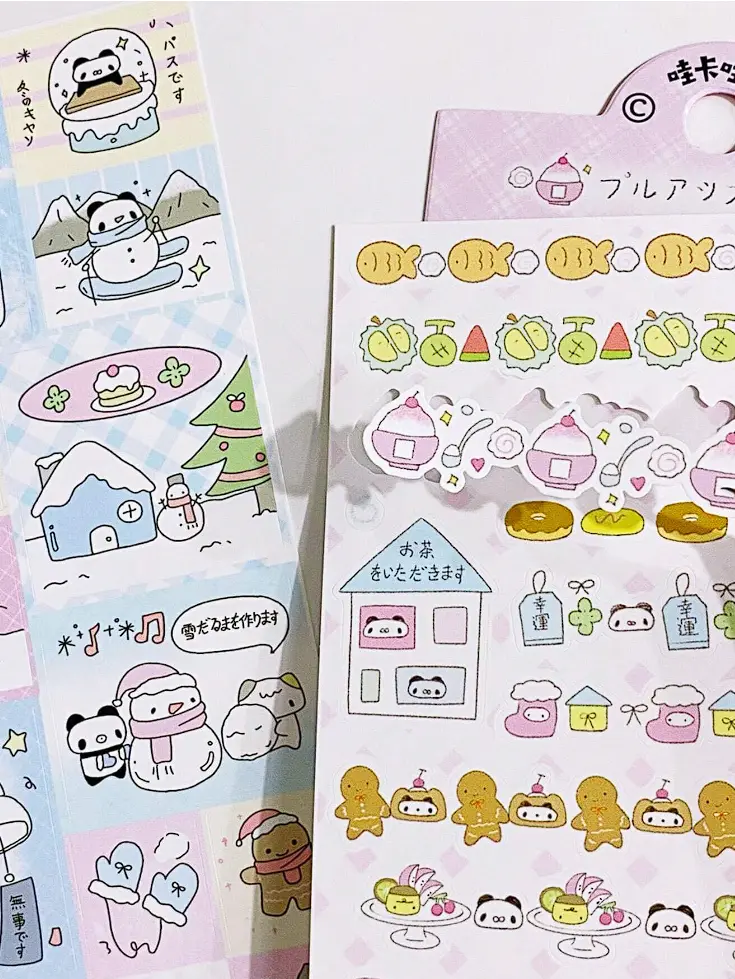Origins of Japanese Stickers
Japanese stickers have a rich history that dates back to the early 1980s. The origins can be traced to the kawaii culture, a phenomenon focused on cuteness and the celebration of adorable characters. This cultural movement heavily influenced the design and popularity of Japanese stickers.
In Japan, stickers are not just decorative items; they are a form of self-expression. From cute animals to vibrant food illustrations, each sticker tells a unique story. The meticulous attention to detail and the creative themes have captivated people worldwide, making Japanese stickers a global trend.
The evolution of Japanese stickers is fascinating. What started as simple designs has now transformed into an extensive collection of styles, including washi paper stickers, 3D puffy stickers, and pop-up stickers. This diversity in designs and textures has contributed to the enduring popularity of Japanese stickers.
Moreover, the quality of Japanese stickers is exceptional. The materials used are of high quality, ensuring that the stickers are durable and long-lasting. This commitment to excellence has earned Japanese stickers a reputation for being not only visually appealing but also practical for various uses.
From stationary enthusiasts to scrapbookers, Japanese stickers have found a place in the hearts of people of all ages. The whimsical designs and charming characters evoke a sense of nostalgia and joy, making them a beloved item in the world of stationery and crafts.
Unique Design Aesthetics
The uniqueness of Japanese stickers lies in their design aesthetics. The attention to detail, vibrant colors, and diverse themes set them apart from other sticker collections. Each sticker conveys a story or emotion, making them more than just embellishments.
One of the key factors contributing to the popularity of Japanese stickers is their versatility. They can be used for a wide range of purposes, from decorating notebooks and planners to personalizing gadgets and gifts. This practicality combined with their artistic appeal makes them a favorite among consumers.
Japanese stickers often feature elements of nature, such as cherry blossoms, cute animals, and traditional motifs. These designs not only showcase Japan’s rich cultural heritage but also resonate with people globally. The seamless blend of tradition and modernity in sticker designs adds to their charm and widespread appeal.
The playfulness of Japanese stickers is another reason for their popularity. Whether it’s quirky characters, humorous expressions, or whimsical illustrations, each sticker brings a sense of fun and lightheartedness. This element of joy makes them a delightful addition to any collection.
Furthermore, Japanese stickers embrace a minimalist aesthetic that emphasizes simplicity and elegance. The clean lines, pastel colors, and minimalist patterns create a soothing visual experience that is pleasing to the eye. This design philosophy resonates with individuals seeking a sense of calm and tranquility in their surroundings.
Cultural Significance
Japanese stickers hold significant cultural value in Japan and beyond. They are not just items for adornment but symbols of creativity, individuality, and self-expression. The act of choosing and using stickers reflects one’s personality and style, making them a personal statement.
In Japanese culture, the exchange of stickers is a common social practice. Whether as gifts among friends or tokens of appreciation, stickers facilitate connections and convey emotions in a lighthearted manner. This cultural tradition has contributed to the enduring appeal of stickers in Japanese society.
Moreover, Japanese stickers often feature elements of traditional folklore, anime characters, and iconic landmarks. By incorporating these cultural references, stickers become more than just decorations; they become pieces of art that celebrate Japan’s rich heritage and modern pop culture.
The influence of Japanese stickers can also be seen in the fashion industry, with designers integrating sticker motifs into clothing and accessories. This crossover between stationery and fashion highlights the cultural significance and widespread recognition of Japanese stickers as iconic symbols of creativity and style.
Overall, the cultural significance of Japanese stickers transcends borders and languages, captivating individuals worldwide with their artistic appeal, cultural references, and emotional resonance. Their enduring popularity is a testament to the universal language of creativity and design.
Popularity in Pop Culture
Japanese stickers have become a ubiquitous presence in pop culture, influencing various industries such as fashion, design, and media. Their distinctive aesthetics and creative themes have inspired artists, designers, and content creators worldwide, leading to collaborations and innovative projects.
The rise of social media has further propelled the popularity of Japanese stickers, with platforms like Instagram and Pinterest showcasing sticker collections and creative uses. Influencers and enthusiasts often share their sticker hauls and creations, fostering a community around this beloved stationery item.
Celebrities and trendsetters have also embraced Japanese stickers as a fashion statement, incorporating them into their outfits and accessories. This mainstream appeal has elevated the status of Japanese stickers from niche collectibles to must-have fashion accessories, further solidifying their place in pop culture.
Anime and manga fandoms have played a significant role in popularizing Japanese stickers on a global scale. Iconic characters and memorable scenes from popular series are often immortalized in sticker form, appealing to fans and collectors alike. The intersection of anime culture and sticker art has created a vibrant subculture within the sticker community.
In essence, the popularity of Japanese stickers in pop culture is a testament to their enduring appeal and creative versatility. As they continue to evolve and inspire new generations of enthusiasts, Japanese stickers remain a beloved icon of self-expression, creativity, and artistic innovation.


